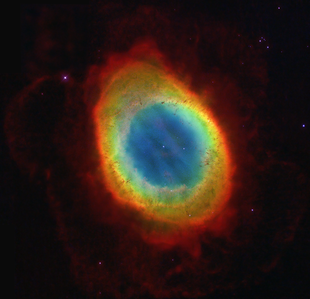Ring nebula
|
Planetary Nebula Data of the Ring Nebula |
|
|---|---|

|
|
| Messier 57, the Ring Nebula in the Lyre, captured by the Hubble Space Telescope | |
| AladinLite | |
| Constellation | lyre |
|
Position equinox : J2000.0 |
|
| Right ascension | 18h 53m 35.079s |
| declination | + 33 ° 01 ′ 45.03 ″ |
| Appearance | |
| Apparent brightness (visual) | +8.8 mag |
| Apparent brightness (B-band) | +9.7 mag |
| Angular expansion | 1.4 ′ × 1 ′ |
| Central star | |
| Apparent brightness | 15 likes |
| Physical data | |
| Redshift | (−64 ± 2) · 10 −6 |
| Radial velocity | −19.2 km / s |
| distance | 2300 ly (700 pc ) |
| Absolute brightness | −0.3 mag |
| Dimensions | 0.2 M ☉ |
| diameter | 0.9 ly |
| Age | 20,000 years |
| history | |
| discovery | Charles Messier |
| Date of discovery | January 31, 1779 |
| Catalog names | |
| NGC 6720 • PK 63 + 13.1 • GC 4447 • h 2023 • M 57 | |
The Ring Nebula (also called Messier 57 or NGC 6720 ) is a planetary nebula in the constellation Lyra .
The nebula is the remnant of a star that shed its outer gas envelope around 20,000 years ago. The gas envelope is expanding at a speed of 19 km / s and currently has an apparent diameter of around 118 arc seconds , which means an absolute diameter of around 1.3 light years at a distance of 2300 light years. In the telescope , the nebula appears ring-shaped, which is why it is often referred to as the ring nebula in the lyre . In fact, the visible gas envelope resembles a torus . In the center of the nebula there is a white dwarf star with a surface temperature of around 70,000 ° C and an apparent brightness of 15.8 mag.
M 57 can be found relatively easily because it is roughly in the middle of the connecting line between the stars β and γ Lyrae .
discovery
M 57 was seen by Antoine Darquier in mid-February 1779 during observations along the orbit of comet Bode (C / 1779 A1 (Bode)). For a long time this was considered to be the first observation of the Ring Nebula. In the same year Charles Messier added it to his catalog . According to new sources, however, Messier himself observed the object for the first time on the morning of January 31.
Darquier compared the appearance of the nebula to a planet, which led the astronomer Friedrich Wilhelm Herschel to call this type of nebula a Planetary Nebula .
Appearance

M 57 can be perceived as a foggy "smoke ring" even in a small telescope from an opening of 10 cm. However, this is relatively small, so that higher magnifications (> 100) are useful. In telescopes with an aperture of 20 cm or more, structures in the ring become visible at higher magnification.
The central star is extremely faint with an apparent brightness of 15.8 m . To observe it, you need a telescope with an opening of at least 25 cm.
Web links
- M57: Calar Alto observatory
- High-resolution recording with a semi-professional amateur telescope ( page no longer available , search in web archives )
Individual evidence
- ↑ SIMBAD Astronomical Database
- ↑ a b c d e f g h i Messier 57 at SEDS
- ↑ cseligman.com
- ^ Don Olson, Giovanni Maria Caglieris: Who discovered the Ring Nebula? In: Sky and Telescope , June 2017, pp. 32–37

